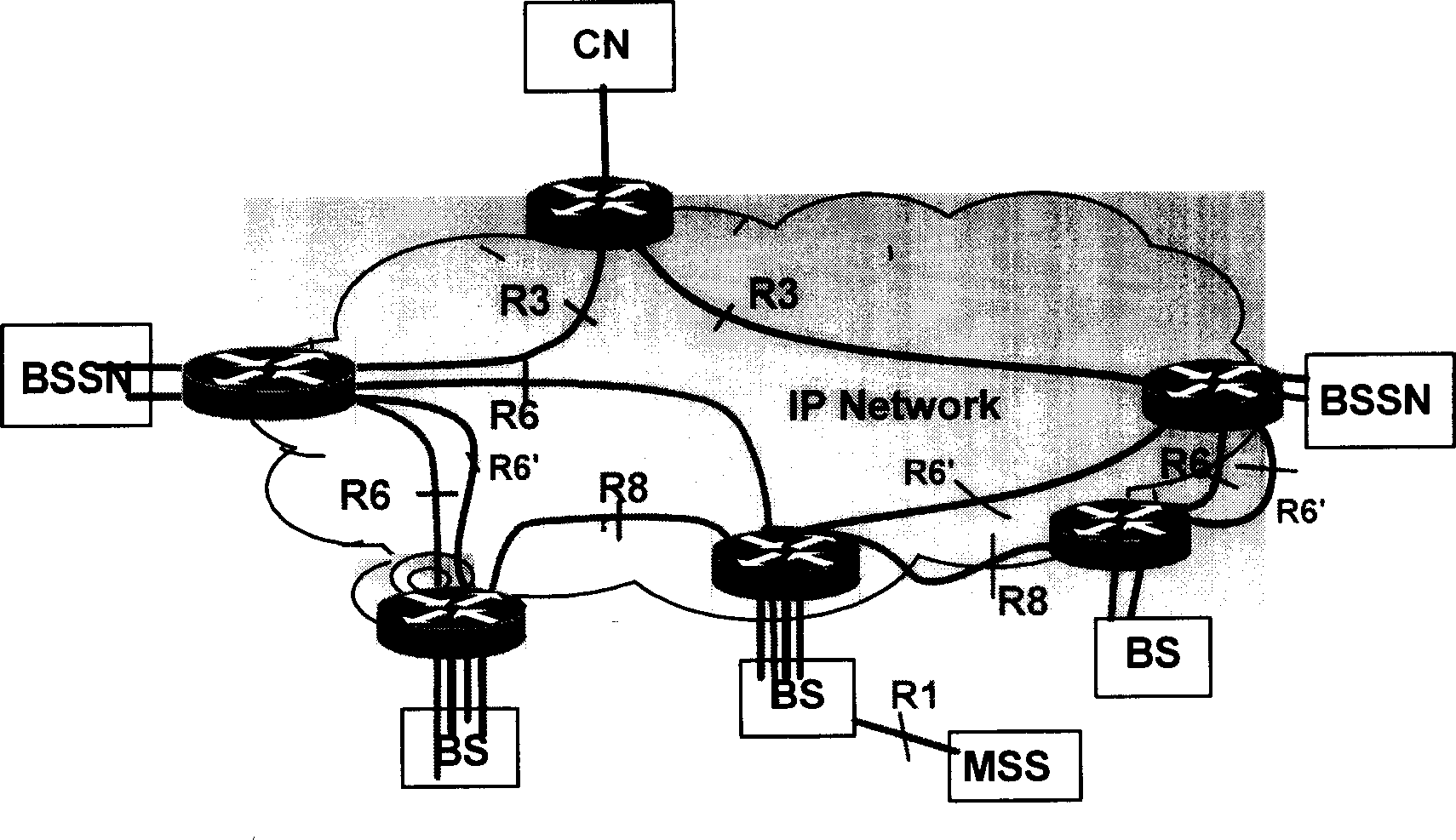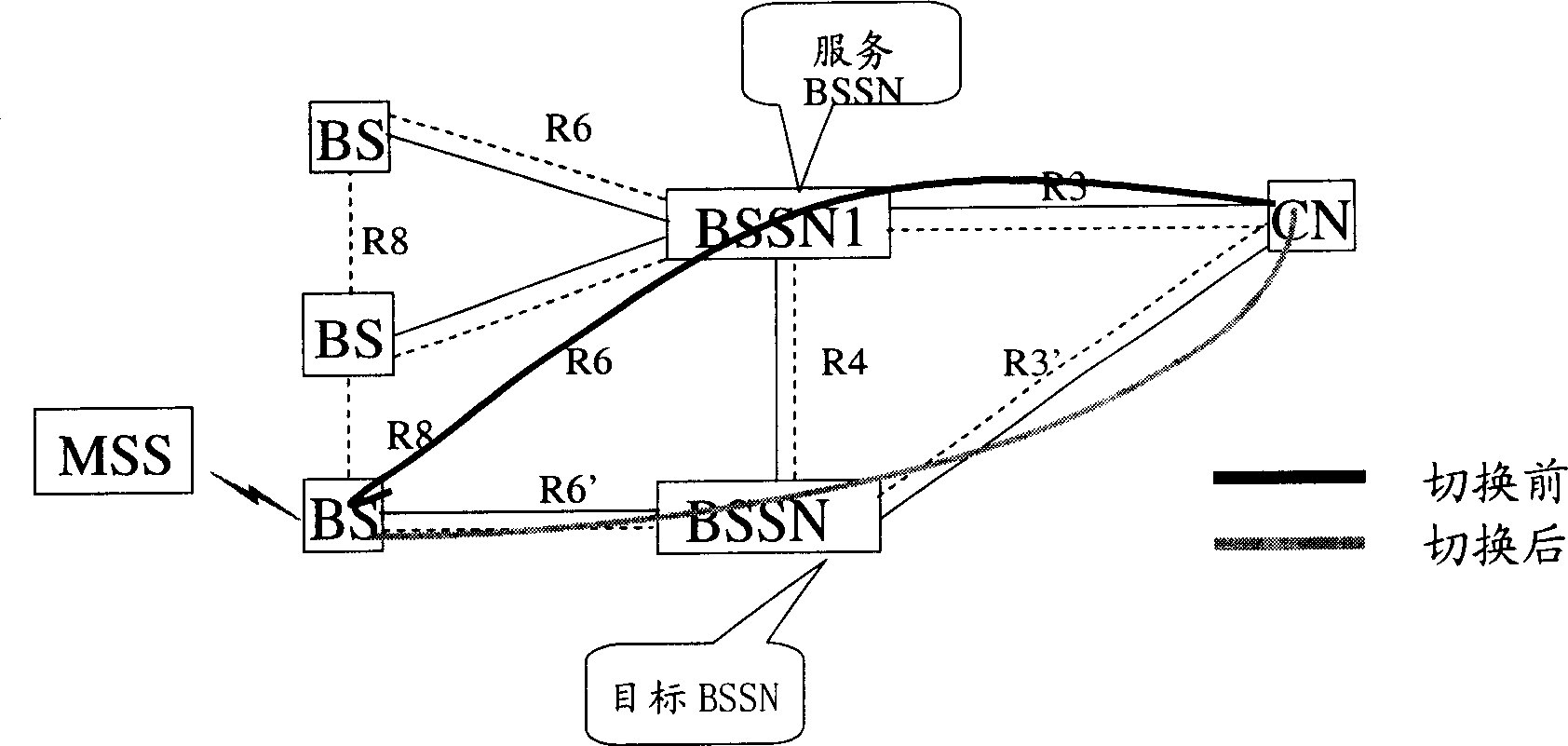Network optimization based on distributive wireless access network
A wireless access network and network optimization technology, applied in the field of communication, can solve problems such as unbalanced network load, different service quality, and reduced network operation efficiency, so as to achieve effective utilization
- Summary
- Abstract
- Description
- Claims
- Application Information
AI Technical Summary
Problems solved by technology
Method used
Image
Examples
Embodiment 1
[0063] like figure 2 Shown is the schematic diagram of the network of Embodiment 1 and Embodiment 2 of the present invention, in which figure 2 In this case, the BS is connected to the BSSN through the R6 interface, and the BSSN is connected to the CN through the R3 interface. If the resource usage and load of the BSSN reach the set threshold, the solution of the present invention will switch the R6 interface, which specifically includes the following contents.
[0064] like image 3 Shown, is the schematic flow chart of embodiment 1 of the present invention, from image 3 It can be seen that the present invention mainly comprises the following steps:
[0065] S11. The BSSN periodically broadcasts its network performance information to the BS.
[0066] Here it can be broadcast through the backbone network message BSSN Resource ADV. The message carries resource and load information of the network, and may include the following information: remaining processor resources (...
Embodiment 2
[0106] The difference between this embodiment and Embodiment 1 is that the handover of the R6 interface is initiated by the BSSN, such as Figure 8 Shown is the schematic flow sheet of embodiment 2, from Figure 8 As can be seen, the scheme may include the following.
[0107] S21. The BSSN periodically broadcasts its resource and load conditions to the BS.
[0108] Here it can be broadcast through the backbone network message BSSN Resource ADV. The message carries the following information: remaining processor resources (resource occupancy rate), memory remaining resources (resource occupancy rate), ingress port remaining traffic, and egress port remaining traffic.
[0109] S22. The BSSN detects its network delay information.
[0110] In this embodiment, the BSSN detects the content of its network performance parameters, which may be the network delay information of the BSSN.
[0111] Different from Embodiment 1, here, the BSSN periodically detects the network delay inform...
Embodiment 3
[0122] During the network air interface switching process, there will be such Figure 9 In the state shown, in this state, the BS does not directly communicate with the serving BSSN, but forwards data through another serving BS, and transmits the context data to the serving BSSN through the serving BS. In this way, if the current BS switches over the R6 interface, There is a case where the switched R6 interface is directly connected to the service BSSN, but for the R3 interface, there is no need to perform related switching, because after the R6 interface is switched, it still exchanges data with the core network through the original R3 interface. like Figure 7 As shown, it is a schematic flow chart of Embodiment 3, the handover process is initiated by the BS, from Figure 7 It can be seen that this embodiment mainly includes the following steps:
[0123] S31. The BSSN periodically broadcasts its resource and load conditions to the BS.
[0124] S32. The BS detects its load...
PUM
 Login to View More
Login to View More Abstract
Description
Claims
Application Information
 Login to View More
Login to View More - R&D
- Intellectual Property
- Life Sciences
- Materials
- Tech Scout
- Unparalleled Data Quality
- Higher Quality Content
- 60% Fewer Hallucinations
Browse by: Latest US Patents, China's latest patents, Technical Efficacy Thesaurus, Application Domain, Technology Topic, Popular Technical Reports.
© 2025 PatSnap. All rights reserved.Legal|Privacy policy|Modern Slavery Act Transparency Statement|Sitemap|About US| Contact US: help@patsnap.com



